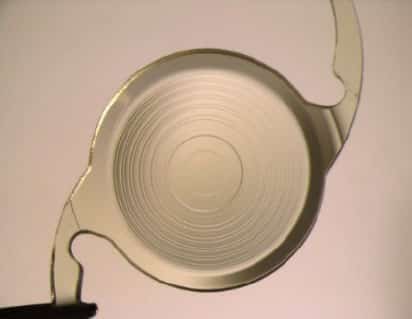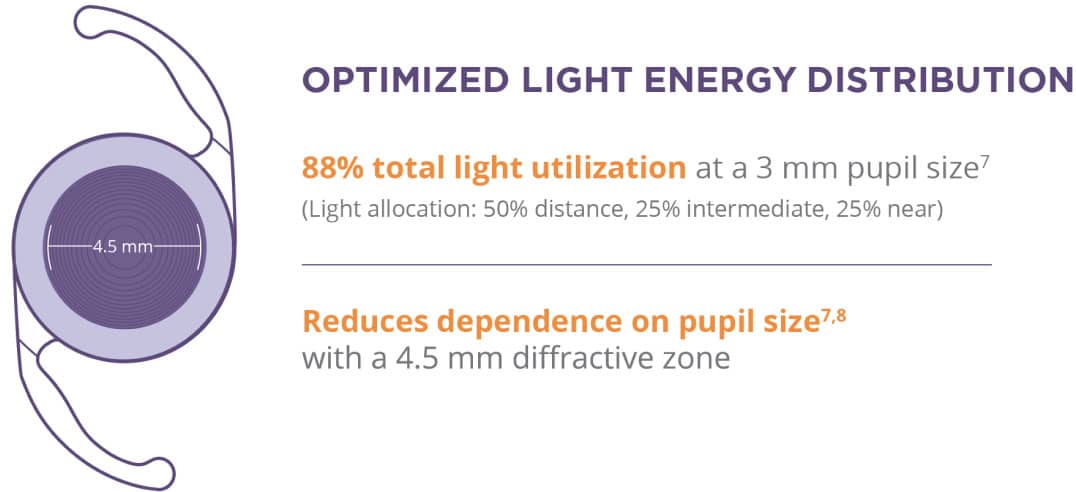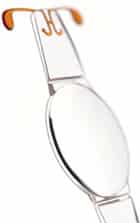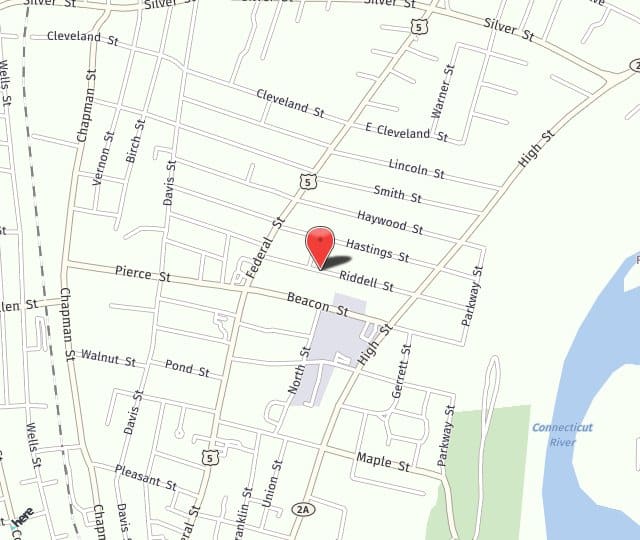
When a cataract-clouded natural lens is removed from your eye, it needs to be replaced. The replacement lens is called an intraocular lens (IOL). It is an artificial lens that is implanted inside the eye permanently. The FDA first approved the use of intraocular lenses for cataract replacement in the early 1980s. In the decades since, the team at Longwood Eye & LASIK Center has been proud to offer a wide variety of intraocular lenses. Dial 1-800-676-5050 today to speak with our office and schedule your IOL consultation!
If I Have Cataracts, Do I Have to Get an Intraocular Lens?
There is no cure for cataracts. The only treatment is the removal of the cataract-clouded natural lens, replacing it with an artificial IOL. If cataracts are not surgically treated, the cloudiness will continue to progress until the eye eventually becomes legally blind. There’s no reason to avoid this surgery. It is incredibly fast, incredibly successful, and returns crystal clear vision to the patient.
Benefits of IOLs?
What is the benefit of having crystal clear vision, free from the increasing cloudiness caused by cataracts? Patients usually don’t realize how much their developing cataract has impacted their vision quality. Because the clouding in the lens develops slowly, the patient doesn’t sense the quality deterioration until it gets to the point where night driving and such is impacted. Today’s choices of IOLs allow you to, basically, choose how good you want your vision to be. You can opt to have clear vision at all distances with the new multi-focal IOLs. Or you can correct for either distance or up close vision, and use eyeglasses for the other. Today’s IOLs can even adjust for astigmatism and improve the refractive errors of near- and farsightedness.
What Are Multifocal IOLs?
Multifocal IOLs correct the full range of vision. Previous lens replacement technologies provided only one improved focal point, distance. This left people dependent on readers or bifocals after cataract surgery. Furthermore, in the past, those who were not yet cataract surgery candidates had no good alternatives for readers, bifocals, or trifocals. Recent advances in lens technology now make it possible to improve vision at all ranges, near through distance, with increased freedom from glasses or contact lenses. Our doctors are proud to offer the most advanced multifocal and accommodating IOLs to give our patients the best possible vision.
How Do I Know Which IOL Would Be Right for Me?
You’ll choose the type of IOL you want implanted prior to your procedure. Your Eye & LASIK doctor will discuss with you the pros and cons of the different lens options. Cost may be a factor, although paying a little more for the latest multifocal lenses is probably worth it over the long run, as they allow clear vision at all ranges of distance. Otherwise, if you’re OK using reading glasses for up-close vision, you may opt for a monofocal lens that provides crystal clear distance vision. This will be a less expensive option.
This is an important decision. You can start with the information on our page here, but it behooves you to also do research on your own into the IOL option.
Advanced Lens Implants for Cataracts
Intraocular Lens Types
During your visit, our doctors will consider all aspects of your eye health, as well as your lifestyle, personality, and expectations. For example, how much reading or computer work do you do? And what do you hope to achieve? From what they learn, our doctors will discuss all of your options and recommend the IOL that is best for you.
Advanced cataract lens implants restore fuller-range vision after cataract surgery. Lenses such as Clareon PanOptix and TECNIS Synergy can deliver clear vision – near through far – without glasses. And Toric lens implants (Clareon Toric, Tecnis Toric) correct astigmatism and sharpen distance vision, freeing you to spend more of your day without glasses. Extended Depth of Field lenses such as Eyhance, RayOne EMV, and Clareon Vivity provide patients with monofocal-quality distance with excellent intermediate and functional near vision. Advanced optics monofocal technology (Clareon, Tecnis, and enVista) improve functional vision, which may also increase patient safety in other low-visibility situations.
Tecnis® Synergy Multifocal IOL
The Tecnis Synergy lens is a multifocal lens proven to provide excellent vision at all distances, under all lighting conditions – day and night. For example, if you play golf, you may be able to see where your drive lands, sink your butt, and write down the score without wearing glasses!

The Tecnis Synergy™ IOLs are intended to improve the ability to see far away (long distance vision). These lenses also are intended to improve the ability to see at an arm’s length distance (intermediate vision) such as working on a computer, applying makeup, or shaving; and at close range (near vision) such as reading, writing, and sewing.
The toric version of these lenses also helps correct a cornea that is less round than normal (astigmatism).
The safety and effectiveness of the Tecnis Synergy™ IOLs was studied in a randomized, controlled clinical trial. One hundred and thirty-five people received Tecnis Synergy™ IOLs and 137 received a monofocal IOL. Vision testing was performed for both groups.
Six months after surgery, people who had their cataracts removed and replaced with Tecnis Synergy™ lenses reported better visual acuity, or sharpness of vision, at near and intermediate distances, when compared to the people who received monofocal IOLs. The Tecnis Synergy™ group also reported less need for eyeglasses than the monofocal IOL group.
How does it work?
The Tecnis Synergy™ IOLs work by bending light rays to allow them to focus on the back surface of the eye, or retina. These lenses are multifocal, that can focus light from objects at multiple distances such as far away, intermediate distances, and close up. People implanted with a multifocal IOL may have less need to wear eyeglasses to see at several distances.

Clareon PanOptix Multifocal IOL
The Clareon PanOptix lens is an advanced multifocal IOL that corrects both distance and near vision. The Clareon PanOptix IOL is designed to provide excellent reading vision and a high level of glasses independence.
The Clareon® PanOptix® IOL is an advanced trifocal IOL equipped with ENLIGHTEN® Optical Technology—a proprietary design that optimizes intermediate vision without compromising exceptional near and distance vision.
Extended Depth of Field IOL
The Tecnis Eyhance IOL, is the first monofocal lens designed to slightly extend the depth of focus
- The breakthrough design of the Tecnis Eyhance IOL delivers a different kind of monofocal experience. The unique shape of the EyhanceTM lens is designed to slightly extend the depth of focus.
- Better Image Contrast in Low Light
Also available in Toric II.
RayOne EMV’s truly non-diffractive optic utilises positive spherical aberration to uniquely extend vision whilst avoiding the problems that can arise with diffractive lenses.
RayOne EMV’s range of focus can be extended further with a customisable offset for Enhanced Monovision outcomes.
- Increased range of focus
- High quality vision: Truly non-diffractive IOL with monofocal levels of contrast sensitivity, dysphotopsia and high levels of patient satisfaction.
- Enhanced monovision: Unique positive spherical aberration design provides a smoother transition between distance and near eyes.
- Now available on the rotationally stable RayOne toric platform
The Clareon Vivity IOL provides patients with monofocal-quality distance with excellent intermediate and functional near vision by harnessing the power of non-diffractive X-WAVE™ Technology.
Advanced Optics Monofocal technology balance Depth of Field and Image Quality
Clareon, Tecnis & enVista monofocals provide advanced optics that are optimized for peak functional vision. These IOLS deliver high-quality, real-world performance so patients can get back to their daily activities, even in low-light conditions. In fact, they’re shown to improve patient safety under low-visibility conditions. These lenses are likely to have meaningful safety benefits for older drivers as well as drivers and pedestrians sharing the road. These IOLS improve functional vision, which may also increase patient safety in other low-visibility situations.

Monovision IOL
With Monovision, patients can improve their range of vision when they combine monofocal IOLs. One eye will provide distance vision while the other provides near vision. However, not everyone can adapt comfortably to this method as the eyes are less balanced.
Is Lens Replacement Surgery Performed At A Hospital?
Our surgeons perform the lens replacement surgery at an outpatient facility. The patient should plan to be at the surgery center for around 2-3 hours.
Preparing for IOL Surgery
To help prevent infection and help the eye heal, your doctor will prescribe antibiotic, anti-inflammatory, and steroid eye drops. In some cases, the doctor will prescribe additional medication to help control eye pressure or other conditions.
How Soon After My Cataract Surgery Will I See Clearly?
After your surgery, your vision will be blurry at first, but it rapidly improves in the first day or two and you will be able to notice an immediate improvement in your vision. Most patients can return to their normal activities the very next day. Full healing can take up to two months, but your vision should be clear within a week or two.
What Will My Recovery Be like After Cataract Surgery?
Believe it or not, this incredible surgery takes just 5-10 minutes! Afterward, we’ll place an eye patch on your treated eye. We give you a protective shield that you will wear when sleeping for the first several days of your recovery. Your vision will be blurry at first. This begins to rapidly improve in just the first couple of days. Your eye may itch somewhat, but, obviously, you must not rub or touch the area. Heavy lifting, bending over, and other actions that create pressure on your eyes must be completely avoided. We provide you with eye drops that prevent inflammation and infection. They also control the pressure inside your eye when healing.
Full healing can take up to two months, but you can return to normal activity in just a few days. You may or may not require glasses for some tasks after your surgery. This depends on the IOL you selected. If your other eye also has a cataract, we usually schedule the second surgery one to two months after the first.
Are There Any Risks To Lens Replacement After Cataracts?
As with any surgical procedure, there will be risks involved. Some of the risks that come with lens replacement surgery can include:
- Infection
- Retinal detachment
- Increase in eye pressure
- Reactions to medication
- Vision changes
Prior to your surgery, our doctors will discuss all these risk and benefits with you. There may also be some side effects, such as redness, scratchiness or sensitivity to light after the procedure.
Book An Intraocular Lens Consultation
If you are interested in learning more about intraocular lenses and lens replacement surgery, please call 1-800-676-5050 or request a consultation online to see if you are a good candidate.




